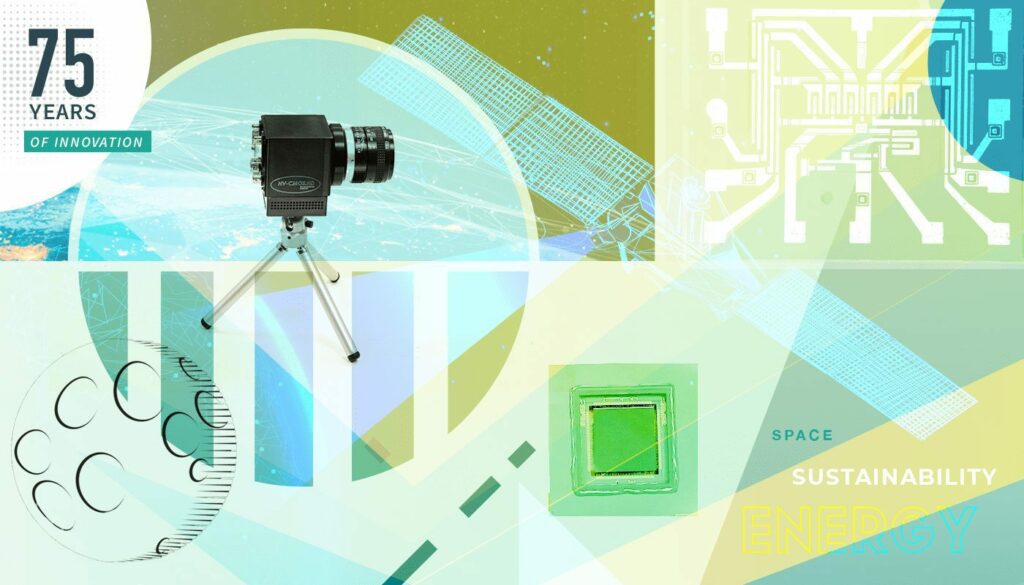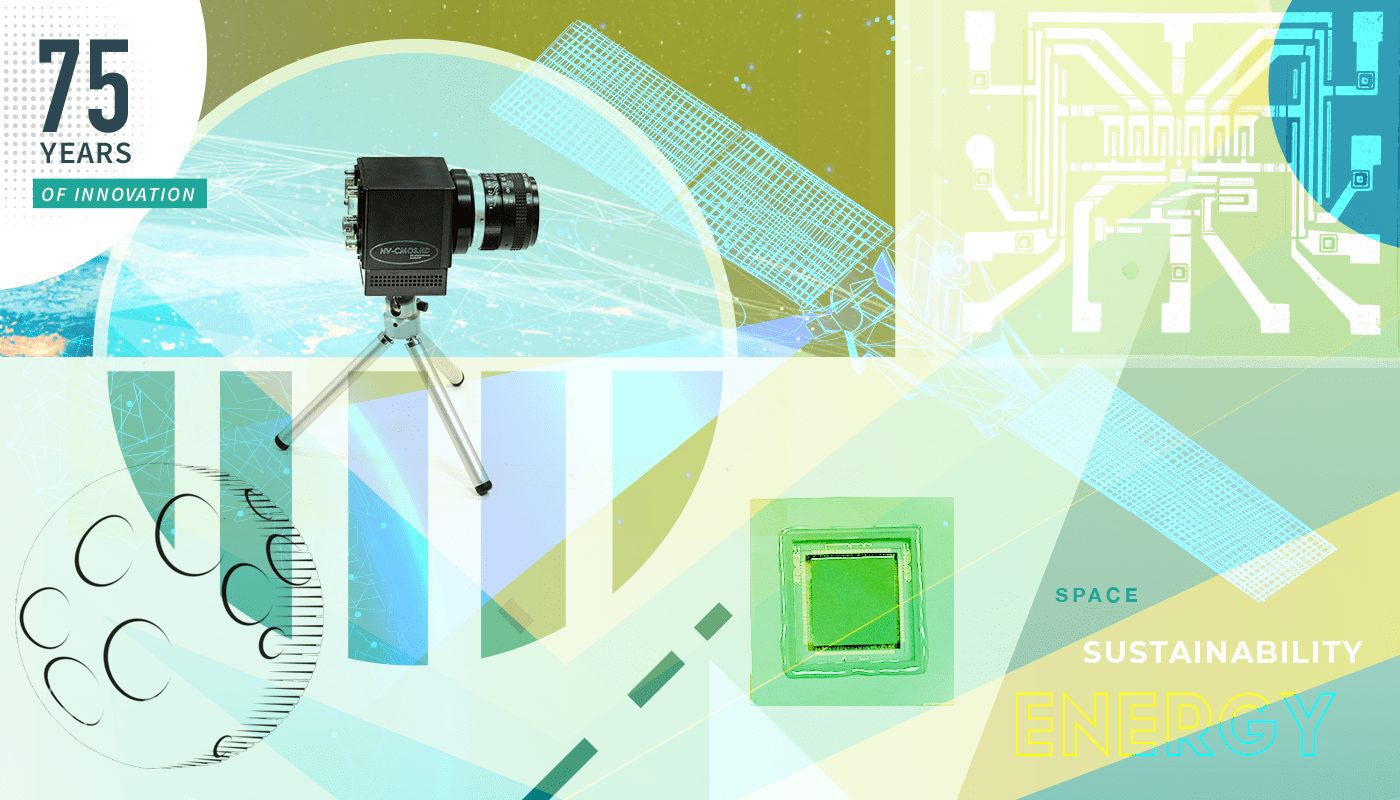The 75 Years of Innovation series highlights the groundbreaking innovations spanning from SRI’s founding in 1946 to today. Each week, SRI will release an innovation, leading up to its 75th anniversary in November 2021.

Developing technology for a cleaner, greener tomorrow.
We don’t believe in incremental improvement. We invent technologies and develop high-performance solutions that change the world. — SRI International
Our precious planet is always on the mind of the researchers and developers at SRI International. Using cutting-edge technologies and delving into the science of space, energy and sustainability has made SRI a leader in these fields. Over the 75-years that SRI has been in existence, it has made some important advances in these areas. Here are some past, present and future demonstrations of SRI’s involvement in Space, energy and sustainability.
How the past has informed the future
Much of science and technology builds upon previous ground-breaking discoveries. SRI International has been fortunate to work with some of the world’s most eminent scientists and technologists to make real changes happen. Some of the most memorable past discoveries and developments include:
Solar electricity
Using the sun to generate energy is a vital component of sustainability. Solar energy is now widely recognized as a way to create clean and sustainable energy. But it was back in the 1950s that SRI helped to shape this sustainability agenda by hosting the first World Symposium on Applied Solar Energy. This symposium proved to be a catalyst for essential innovations in the area of solar electricity. Developments that changed the nature of solar energy include the amorphous solar silicon cell, patented by SRI in 1976. This invention led the way for improved efficiencies and provided a platform for future innovation in sustainable energy.
Air pollution/ozone depletion
Air pollution has had an impact on human health for centuries. In 1947, SRI International began exploring how pollutants impact human health. Future decades saw further work into the impact of air pollutants from cars, industry, smoking, etc., on the pathogenesis of human respiratory diseases. In the 1980s, this work was extended to cover ozone depletion, ozone being an atmospheric layer that protects animals and plants from ultraviolet rays. SRI was part of a team that explored the role of chlorofluorocarbons (CFCs) in the depletion of stratospheric ozone.
Semiconductors (CMOS, Complementary Metal Oxide Semiconductor)
Computers drive many innovations. But the powerful computing we all use today would not exist without a 1965 development by SRI, the Complementary Metal Oxide Semiconductor (CMOS). Today, most of the world’s electronic circuitry is powered by CMOS chips, which are essential in increasing processing speed with a reduced power requirement.
TIROS-1 (Television InfraRed Observation Satellite)
The weather satellites used today to predict weather patterns started life in an SRI lab. Often SRI works in collaboration with other parties to build multi-disciplinary, highly experienced teams. The launch of TIROS-1 in 1960, the first successful weather satellite, was such a collaboration. The project members included RCA (now part of SRI International), NASA and other partners. TIROS-1 became the standard for future meteorological satellites.
Out of the past comes a greener, cleaner tomorrow
Past developments from the SRI International stable have generated many innovations that we regularly use today. The CMOS development in 1965 paved the way for the 2019 development of a digital night-vision camera that now supports the U.S. Army’s Integrated Visual Augmentation System (IVAS) program. SRI’s commitment to clean air and human health has led to developments in clean materials and green technology, such as hydrogen storage and high-performance coatings.
Building upon past developments is providing key opportunities for future innovation. These include:
Sustainability and energy
Drinking-water technologies
Having clean and accessible drinking water is essential for human life. SRI International is involved in the fabrication and scale-up of membranes for water purification. SRI to develop these technologies to future-proof clean water availability in water-scarce nations.
Waste-water treatment technologies
In 1998, SRI developed a process called Assisted Hydrothermal Oxidation (AHO). This process created an environmentally safe and cost-effective method for the disposal of hazardous materials such as wastewater, chlorinated wastes, chemical weapons, and explosives. SRI continues to build on this work and develop the future technologies needed for sustainable water treatment. These technologies include the further development and commercialization of AHO and the development of the hot water extraction (HWE) method to recover hydrocarbons from drilling mud/oil spills and clean the water produced by these processes.
Carbon capture technologies
Carbon capture is an important requirement in processing carbon dioxide (CO2) before it enters the atmosphere; as such, the process is a vital part of the armory used to protect our planet from climate change. SRI International is involved in the proof of concept, bench-scale and pilot development of chemical absorption methods. These include pre-combustion applications such as the Chilled Ammonia process, the ammonium carbonate-ammonium bicarbonate (AC-ABC) process and the Mixed Salt Process (MSP), as well as membrane-based technology for pre-combustion applications.
SRI International will continue to enhance carbon capture capabilities in the coming years. These innovations include large-scale testing and demonstration of CO2-Capture technology within power plants.
Space
Satellite tracking-as-a-service
SRI International has a long history of working in the area of space technology advancement. An exciting new development is the use of radar data to detect space debris to prevent satellite collisions. This venture embodies the spin-out and collaboration model used by SRI across the decades to commercialize innovation. The start-up, LeoLabs (Low Earth Orbit) plays a central role in taking SRI into the commercial space of satellite tracking-as-a-service. LeoLabs started as an SRI Ventures spin-out in 2016 and now works to commercialize a network of ground-based, phased-array radars and provide satellite tracking-as-a-service. LeoLabs was made possible by the work performed by SRI on the Advanced Modular, Incoherent Scatter Radar (AMISR). The AMISR was developed for advanced research of the aurora borealis (northern lights), upper atmosphere, and ionosphere for the National Science Foundation. As part of the spin out process, SRI supported the LeoLabs team in enhancing the radar architecture for satellite tracking. This allowed radar data to be used as actionable information to prevent orbital collisions.
Next-generation software systems and quantum sensors
Next-generation software systems and quantum sensors are under development at SRI to improve pointing/navigation/timing (PNT) capabilities for satellite operations. SRI International also manages a consortium of corporate, academic, and federal experts that make up the Quantum Consortium (QED-C). QED-C is working to develop a robust quantum ecosystem to take quantum technologies into the future.
SRI International is built upon an ethos of innovation. World-class experts collaborate with global organizations to drive scientific and technological developments for the advancement of humankind and to ensure a cleaner and more sustainable future.
Resources
Solar Electricity: https://medium.com/dish/75-years-of-innovation-solar-electricity-8e3931c5160
Air Pollution/Ozone depletion: https://medium.com/dish/75-years-of-innovation-air-pollution-ozone-depletion-6bc1276ae0be
Electrostatic Discharge rods: https://medium.com/dish/75-years-of-innovation-electrostatic-discharge-rods-8bb1ed27b60c
Semiconductors (CMOS, Complementary Metal Oxide Semiconductor): https://medium.com/dish/75-years-of-innovation-cmos-complementary-metal-oxide-semiconductor-5629de08d41
SRI MSP technology: https://netl.doe.gov/node/10671
Assisted Hydrothermal Oxidation (AHO): https://www.sri.com/hoi/hazardous-waste-disposal/
Scientific American, Carbon Capture Technologies Are Improving Nicely: https://www.scientificamerican.com/article/carbon-capture-technologies-are-improving-nicely/
LeoLabs: https://www.leolabs.space/



